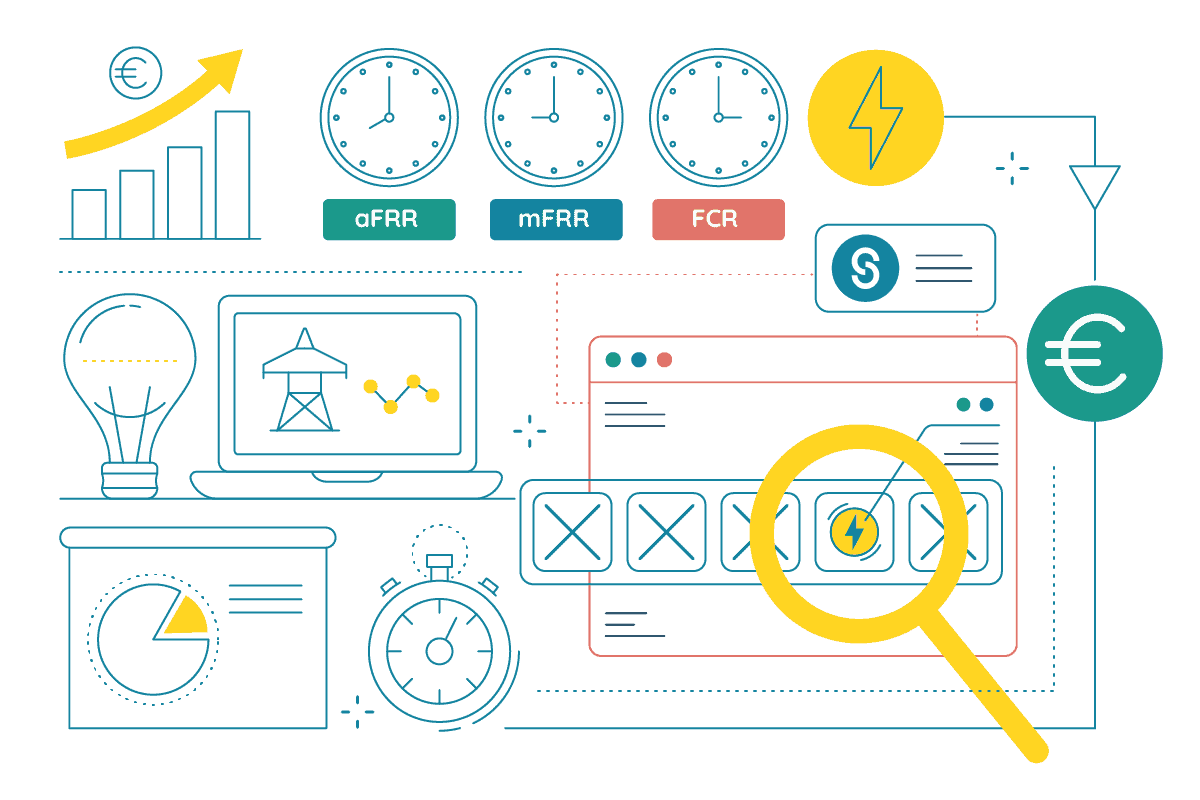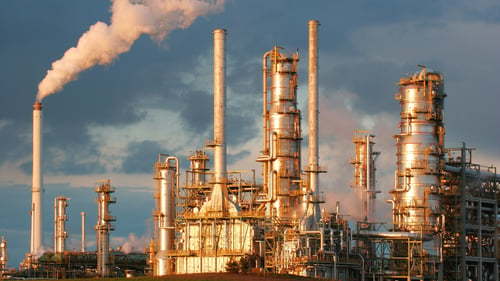What are Energy Markets?
.jpg?width=768&name=Article%20Thumbnails%20-%201920x1080%20new%20website%20(12).jpg)
Energy markets are arenas for the buying and selling of energy. People have always traded physical energy-giving commodities such as coal or wood, but today’s energy markets are much more complex.
The introduction of electricity grids from the 1930s onwards was a game-changer for the electricity industry because it meant that power plants no longer needed to be located on the sites that would be consuming the energy. Integrated national power systems allowed countries to pool energy resources from different locations and transmit energy to wherever the demand was. Now, every country has a national grid that distributes energy through different markets.
Jump to:- Understanding energy markets
- How energy markets work
- Energy market trading
- Types of balancing markets
- Why are energy markets and balancing markets important?

Understanding Energy Markets
There are different kinds of energy market. Most energy users are familiar with the retail market, where they have a choice of suppliers and tariffs.
Traders buy and sell energy commodities like oil and gas on international exchanges, usually through futures contracts. Rather than actually buying and selling barrels of oil, investors buy the option to purchase or sell a certain quantity of this commodity in the future. They are gambling on their predictions of rising or falling prices being correct.
Understanding wholesale energy markets relies on the fact that we can't store electricity in large quantities. This means that grid operators are always working to balance the output from generators with demand from consumers. Electricity is traded between the generators who produce it, the suppliers who sell it on to the end user, and traders who move between them. This creates a well-functioning wholesale electricity market where this balance is maintained.
Bilateral energy markets trading between generators and energy suppliers often works on pre-arranged principles. Rather than striking each deal from scratch, generators and suppliers will often have an agreement in place about how each electricity contract between them should work. Individual contracts will vary on the amount of electricity to be bought, and the price agreed, but they will be based on these principles. To help the Transmission System Operators (TSO) with its vital job of balancing supply and demand, generators will tell the grid operators how much electricity is about to be traded.
The TSO also keeps track of transactions in the Day-Ahead Energy Market. Suppliers then buy electricity for the next day based on the agreed price is defined by both supply and demand, following marginal price mechanisms.
Finally, the national grid does its own purchasing in real time through different balancing services. Ancillary services like demand response are used to help balance the demand and supply of energy beyond generation and transmission. They are a final measure to ensure grid stability and security. With the world increasingly relying on renewables, these ancillary services help to offset the unpredictable supply of sun and wind energy.
How Energy Markets Work
Data is the key to energy market trading. The cost of generating power may vary because of factors such as the intermittency of renewable output, underlying fuel costs and supply issues. Transmission is another variable; the system always loses some electricity during transmission due to its physical limits. This loss could be greater if there are any problems with the transmission network, such as the need to take lines out of service for repair.
All these changing variables affect the price of electricity, so markets use the Locational Marginal Pricing (LMP) as a benchmark. The LMP is continually changing as the underlying costs change, so it provides a pricing signal in close to real time that is helpful for both buyers and sellers.

Energy Market Trading
There are a few different ways that energy trading can occur.
Intraday Trading
Energy market trading that occurs on the same day as the delivery of energy. Bid prices dictate and assess prices continuously for every transaction that occurs. This results in there being no fixed price for energy for intraday trading
Day-ahead Trading
Energy market trading that occurs the day before the delivery of energy to buyers. The last accepted bid on the market dictates the prices.
Buyers will usually opt for both methods. A supplier might buy electricity on the day-ahead market to cover anticipated consumer demand, but then find on the day that demand is higher than expected. In that case, they would cover the difference by buying it on the intraday market. Both types of purchase use the LMP to guide them.
Types of Balancing Markets
One of the big challenges for grid operators is to keep electricity grids at a specific frequency, which is 50Hz in Europe. They have to stay very close to this, because a tiny deviation of just 0.2 Hz either way can cause outages. So they use balancing energy to keep everything running. There are four types of balancing energy and each of them has its own energy market.
Frequency Containment Reserves (FCR)
Frequency containment reserves (FCR) respond automatically and very quickly (usually within 30 seconds) to any changes in frequency. FCR automatically intervenes within seconds to help restore safety and security of the grid by balancing supply and demand of electricity. We can also refer to it as the primary control reserve and is the first response to frequency disturbances.
Within Nordic countries, there are two types of FCR: Frequency Containment Reserve for Normal Operation (FCR-N) and Frequency Containment Reserve for Disturbances (FCR-D). FRC-N works to keep the frequency within the range of 49.9 Hz to 50.1 Hz, while FCR-D reacts when the frequency goes outside the standard range.
The biggest market for FCR procurement is called the FCR Cooperation and includes transmission system operators from eight different European countries. Grid operators bid for four-hour chunks of FCR energy and then sign contracts directly with the balancing service providers.
Automatic Frequency Restoration Reserve (aFRR)
Automatic Frequency Restoration Reserve (aFRR) is a secondary balancing service that helps keep the grid frequency stable and within certain parameters. In most countries, this is +/- 0.2 Hz either side of 50 Hz. It is not automatic - an activation signal from the transmission system operator triggers it. It is slower than FCR but still activates within five minutes.
The European market platform for aFRR is known as PICASSO (Platform for the International Coordination of Automated Frequency Restoration and Stable System Operation). PICASSO went live in June 2022, but many European countries will not be joining until 2024.
Manual Frequency Restoration Reserve (mFRR)
Manual Frequency Restoration Reserve (mFRR) is a third line of response for when frequency fluctuations have not been solved by FCR or aFRR. The use and definition of mFRR varies in different countries, but Europe is in the process of standardising this and creating a market for this kind of service to be traded.
The European Network of Transmission System Operators (ENTSO-E) specifies that the full activation time of mFRR (the time between the activation request and the full delivery of the energy) should be between five and 12.5 minutes.
The platform for trading mFRR will have the name MARI (the Manually Activated Reserves Initiative).

Why are Energy Markets and Balancing Markets important?
Balancing markets are important for a number of reasons. They help to keep lights on, and create a more energy efficient system. But they also allow for a more sustainable system.
Independent aggregators, like Sympower, can help businesses participate in balancing markets through demand response services. This is where businesses change their energy consumption to help maintain balance between the demand and supply of electricity.
Aggregators help businesses identify this flexibility in order to access new revenue streams. By working closely with TSO’s, aggregators can offer financial incentives to businesses for offering this flexibility on the balancing market.
This flexibility is an important step towards integrating renewables into our energy system. Without energy markets and the use of demand response, this would be a lot more difficult. Allowing businesses to indirectly participate in energy markets is helping the EU reach its sustainability goals.
Learn more about Balancing Services
Download our brochure.
Other articles you might find interesting
-
 Demand-side flexibility30 March 2023
Demand-side flexibility30 March 2023Five Myths About Demand Response, Debunked!
Read more -
.jpg?length=500&name=Article%20Thumbnails%20-%201920x1080%20new%20website%20(35).jpg) Demand-side flexibility30 March 2023
Demand-side flexibility30 March 2023smartEn Executive Director Michael Villa on the future of energy flexibility in Europe
Read more -
 Energy management30 March 2023
Energy management30 March 2023Going From Passive to Active as an Energy Consumer - Q&A with Gianluca Rimini
Read more -
.jpg?length=500&name=Article%20Thumbnails%20-%201920x1080%20new%20website%20(6).jpg) Demand-side flexibility30 March 2023
Demand-side flexibility30 March 2023Five Times Demand Response Saved the Grid
Read more -
.jpg?length=500&name=Article%20Thumbnails%20-%201920x1080%20new%20website%20(9).jpg) Energy markets30 March 2023
Energy markets30 March 2023Why do Energy Prices Change?
Read more -
.jpg?length=500&name=Article%20Thumbnails%20-%201920x1080%20new%20website%20(13).jpg) Energy markets30 March 2023
Energy markets30 March 2023Load Shedding Explained
Read more -
.jpg?length=500&name=Article%20Thumbnails%20-%201920x1080%20new%20website%20(15).jpg) Energy markets30 March 2023
Energy markets30 March 2023How to Grow with the Energy Transition
Read more -
.jpg?length=500&name=Article%20Thumbnails%20-%201920x1080%20new%20website%20(24).jpg) Energy markets30 March 2023
Energy markets30 March 2023Securing Europe’s energy supply: the role of platforms for ancillary services
Read more